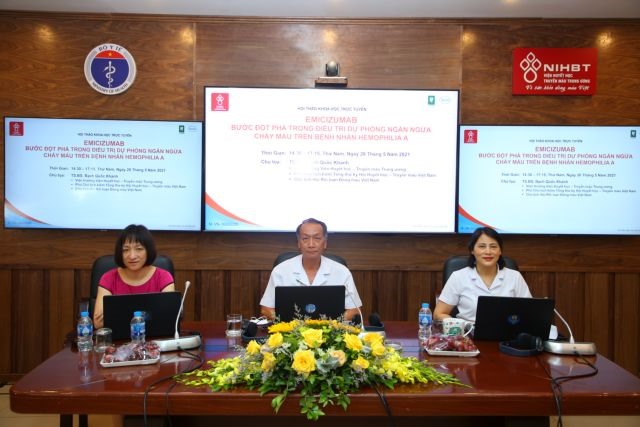 Society
Society

According to the Ministry of Health, there are more than 6,200 people with haemophilia in Việt Nam, of which nearly 40 per cent have not been diagnosed or treated.

|
Delegates attend the online symposium on haemophilia treatment on Thursday in Hà Nội.— Photo NIHBT
HÀ NỘI — Local and international haematology experts discussed the latest studies and scientific advances in haemophilia treatment at an online symposium on Thursday in Hà Nội.
The event, entitled 'The new prophylaxis treatment for Haemophilia A patients', was organised by the National Institute of Hematology and Blood Transfusion (NIHBT) in collaboration with healthcare firm Roche VietNam.
Participants heard that haemophilia is an inherited genetic disorder that impairs the body’s ability to make blood clots, caused by decreased or abnormal function of coagulation factor VIII and IX.
Haemophilia can cause a person to bleed even without being injured for a long duration and repeat many times. Currently, there is no long-term cure for haemophilia. If not detected early, diagnosed and treated properly, bleeding episodes will deform the muscles and joints, causing pain and difficulty in movement and affecting the quality of the patient’s life significantly. If the bleeding occurs in risky areas, it can be fatal.
"Studies have shown that the new method with emicizumab, a humanised bispecific antibody, for the treatment of haemophilia A, has overcome the limitations of existing methods, as it helps to maintain a low bleeding rate in haemophilia A patients of all ages. The longer duration of treatment with emicizumab, the lower the annual bleeding rate, the higher the percentage of patients that stop bleeding,” said Prof. Guy A Young, Keck School of Medicine, University of Southern California.
According to the Ministry of Health, there are more than 6,200 people with haemophilia in Việt Nam, of which nearly 40 per cent have not been diagnosed or treated.
Dr Bạch Quốc Khánh, Director of the National Institute of Hematology and Blood Transfusion, Chairman of the Việt Nam Hemophilia Association said prophylaxis by regularly supplementing clotting factors to prevent bleeding has been applied in many countries for decades.
“Previously, most haemophilia patients were only treated when there was bleeding, resulting in patients suffering from pain and complications in muscles and joints. Early detection and prophylaxis are the best way to reduce risks for patients as well as saving treatment cost and reducing the burden on the health insurance fund. If prophylaxis can be deployed on a large scale and supported by health insurance, it will create a better future for patients," said Dr Khánh.
Khánh added that although haemophilia patients cannot be completely cured, early diagnosis and appropriate treatment can help them maintain their health and have an almost normal life. Therefore, enhancing diagnosis work, early detection and treatment quality is a priority that can help the patient to have a better quality of life.
At the moment, Việt Nam has 10 haemophilia treatment centres. The NIHBT’s Hemophilia Centre currently is managing and treating nearly 2,000 patients. It is gradually implementing prophylaxis treatment (treatment of bleeding complications) for children with severe haemophilia and patients with joint complications. — VNS




